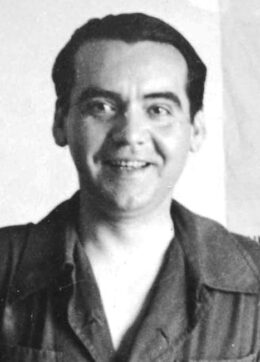
Printed
44 pages
Author(s)
El maleficio de la mariposa
El maleficio de la mariposa (The Butterfly’s Evil Spell) is the adaptation of a poetic composition recited by Federico García Lorca in June 1919 in Grenada, during a banquet to which Gregorio Martínez Sierra, the director of the theatre Eslava in Madrid, and his leading actress Catalina Bárcena were invited. Having fallen under the spell of this fable telling the tragic fate of a cockroach that had fallen in love with a butterfly with broken wings, Martínez Sierra asked the poet if he could make it into a tragedy which would be performed at the theatre Eslava. It seems that Lorca also chose the title of the tragedy. Staged with sets by Fernando Mignoni, costumes by Rafael Barradas and the dances by famous dancer La Argentinita, who played the role of the butterfly, the first performance caused public scandal and provoked such a disorder that the play was only run for four days, from the 22nd to the 25th of March 1920. The presence on stage of actors dressed as insects, expressing their metaphysical and sentimental concerns, became an object of ridicule.
Very lyrical and heavily inspired by symbolist theatre, the text is not easy to stage; some critics have attributed this difficulty to the young playwright’s lack of experience. But it is necessary to understand the place of text within all the tragedies imagined by Lorca between the years 1918-1922. The sources he took its inspiration from are, on the one hand, the auto sacramental, and on the other hand, puppet theatre, that is to say theatrical forms which give a primordial role to symbols, allegories and metaphors. Lorca, without a doubt, wrote his play so that it would fit the small space of a hand-puppet booth: sprinkled with gigantic daisies and populated with insect characters , the setting, described in the stage direction which introduces the second act, is described as a teatrito (small theatre), which explicitly evokes puppet theatre. But, most probably under the influence of Russian Ballets, Gregorio Martínez Sierra wanted to stage Lorca’s play as a sort of ballet. In a letter meant for Lorca written in January 1920, he wrote: “So, I have decided to stage The Infinitesimal Comedy (the title that was chosen at first by Lorca for the play), not with puppets. Instead I will do it according to the proper rules - that is to say with actors dressed up as small animals. Barradas has already prepared a preliminary draft, and tomorrow he will make the actors try on the costumes which are already finished.” It seems that Lorca heavily pressed for the actors to be replaced with puppets, and the large stage of the Eslava with a hand-puppet booth, but Martínez Sierra persisted with his idea.
The protagonist falls in love with an unaccessible being
A small colony of cockroaches lives in the centre of a flowery meadow. Doña Curiana (Lady Cockroach) is sad: her son, Curianito el Nene (Cockroach Junior) is a daydreaming poet, lost in stargazing. Against his mother’s wishes, who keeps insisting on it, he refuses to marry the coquette Curianita Silvia (Sylvie the Cockroachette). Curiniato does not love her; he is waiting for an ideal Love, a dream “clung to the star that looks like a flower”. Suddenly, Alacrancito el Cortamimbres (Slice-Wicker the Scorpion), an old lumberjack and a drunkard, appears and threatens to eat them all. Then, a group of female Cockroaches from the countryside appears. They are carrying a white butterfly with a broken wing: the Butterfly (or Moth). The Curiana Nigromántica (The (female) Necromancer Cockroach) tends to the wounds of the Butterfly and asks doña Curiana to take her home with her and keep watch over her. Curiniato falls madly in love with the Butterfly, who wakes up during a full moon, and starts beating her wings and dancing, without paying attention to the desperate Curianito’s inflamed declaration of love. The play, the manuscript we have of it being incomplete, stops at this moment and ends with a funeral procession which carries the lifeless body of Curianito away.
First performance
Teatro Eslava, stage direction by Gregorio Martínez Sierra
Publications and translations
Federico García Lorca, Obras completas. Madrid : Aguilar, 1954
Federico García Lorca, Teatro completo. Barcelona : Galaxia Gutenberg, 2016
Federico García Lorca, Œuvres complètes, trad. André Belamich, vol. 2. Paris: Gallimard, 1990.
(French)Federico García Lorca, The Butterfly's Evil Spell, in Five Plays: Comedies and Tragi-Comedies. Trans. James Graham-Lujan and Richard L. O'Connell. London: Penguin, 1970.
(English)
